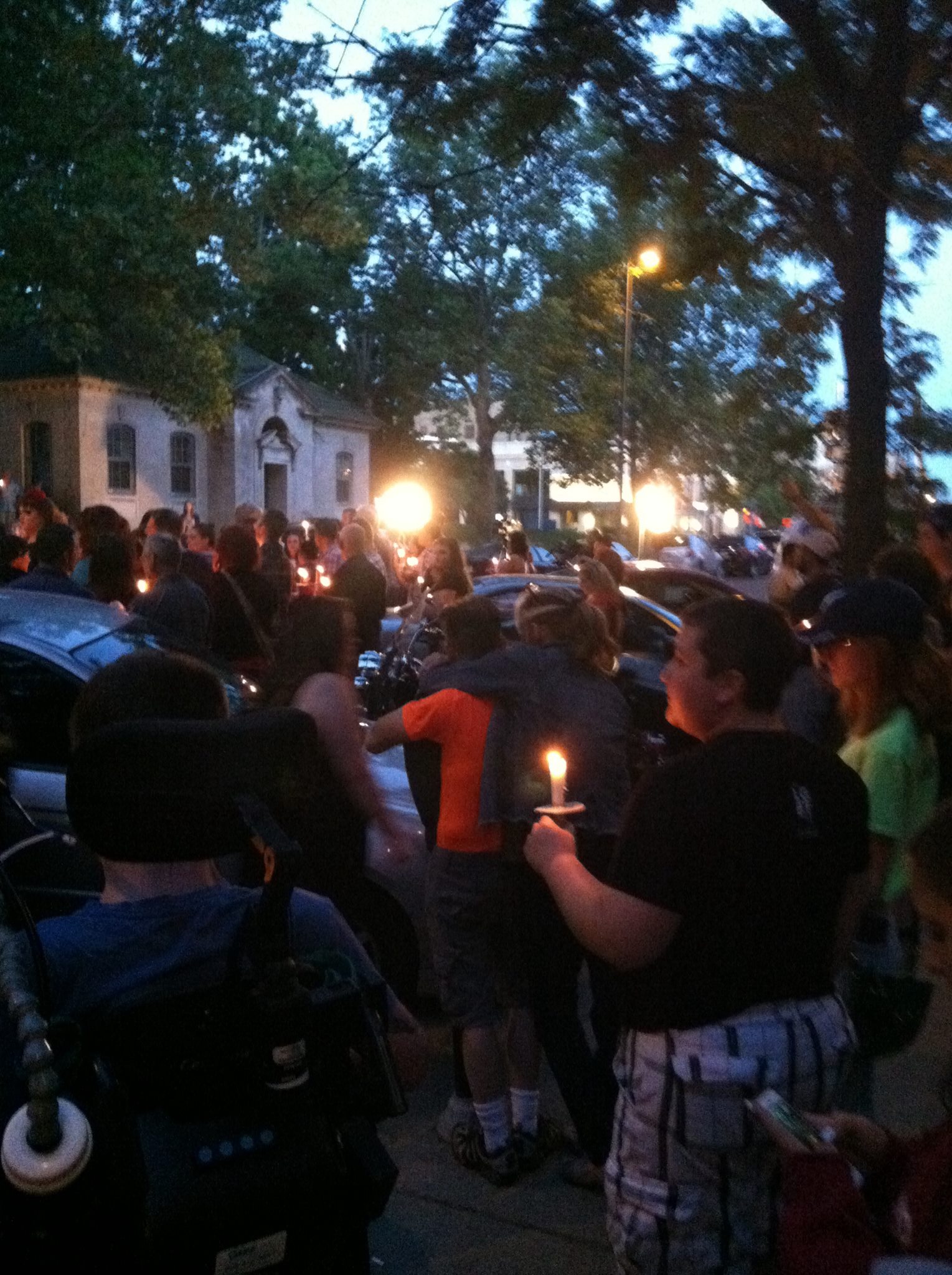I met Max nearly 10 years ago. I don’t remember all the details of our first conversation, but I remember it was summertime. I remember sitting in her dining room and telling her all about myself, something that I usually find excruciating and awkward and horrible. Usually when people ask you to talk about yourself, I get this feeling that they’re really asking, “Why should I care about you? What do you have to offer me?” With Max, nothing could have been farther from the truth.
Thank God for therapists.
I had graduated from a master’s program the year before and I was burned out and disillusioned with academia—feelings that aren’t altogether unfamiliar a decade later as I work on a PhD. Adrift and unfulfilled by my work, Max took me under her wings. I call her my Jewish lesbian mom, only half joking.
In addition to her work as a therapist and social worker, Max helped organize the response to the AIDS epidemic in Lansing, Michigan. Toward the end of 2015, I recorded a conversation about this for a former employer’s blog. After leaving that job, I always rued not having saved a copy of the blog for myself. The post disappeared from the website, and the company was later acquired.
But look what a little spring cleaning can bring. Digging through my inbox, I found a copy of our conversation transcript, which I am so excited and grateful to be able to share.
Conversation with Max, November 2014
In broad terms, can you talk about what the climate was like in the 1980s before people even knew what AIDS was?
When AIDS first surfaced, it was called GRID [gay-related immunodeficiency]. There really wasn’t any treatment, and people were dying from secondary events—the opportunistic infections.
It was sad because of the isolation people were being put in, that it was so new everybody was fearful. There were comparisons to the need for people to be isolated together somewhere almost like a leper island or a leper colony.
When was this?
This was probably ’82 or ’83.
In my private practice, I started seeing people with AIDS, and they were getting sick. Many of them were getting sick and dying very quickly. People were afraid to treat them. People were afraid to touch people with AIDS. The myths were strong, the belief that bodily fluids including sneezing, coughing, tears—it was all considered putting people at risk.
Hospices at the time and nursing homes did not want to accept anyone with AIDS for fear of contagion. We were able to convince Hospice of Lansing to start doing home care for people with AIDS, so I was really involved in providing some home care.
I remember going to the hospital to visit one of my clients who had Kaposi sarcoma, which is a cancer that forms lesions on the face and pneumocystis pneumonia. I went in the hospital to see him, and they had me gown up. I remember going over and taking his hand. It felt so strange because I had gloves on and had a mask on. I looked like an alien. He said, “You know, people are afraid to touch me.” At that point, I said, “OK, I’m not afraid to touch you.” I took off my gown and my mask and we hung out together. I believe he died not too long after that.
Another one of my clients who had the opportunistic infection that affected vision, painted a picture of what it looked like to look out of his eyes. It was such a changing event for me. Even though his vision was going, he was actually able to draw this representation because he wanted people to understand what it was like to be on the inside looking out.
I went to so many funerals between 1983 and the mid-90s. People were lucky if after diagnosis they would live a year.
Then they came out with the cocktails, so folks were wearing watches with timers because the cocktails, as they called them, were so massive and they had to remember when to take which pills throughout the course of the day. Sometimes people were taking 10, 20 pills at various times and in various combinations throughout the course of the day.
At once?
They’d be broken up. That was also early on in the time that people were cashing in their life insurance so they could pay for medications and they could live, because people were losing their jobs. Then all of a sudden, it seemed like life expectancy began to change and people were living longer—but they’d already cashed in their life insurance. They weren’t necessarily being taken back into their places of employment. It was just awful. They had no life insurance. They had no benefits. They had no medication.
People were losing their houses. Families didn’t want people with AIDS moving back home because everybody was afraid. People were afraid they would get it.
Now there are young people who didn’t live through the really ugly, scary times, so there’s a sort of a sense that it won’t happen to them, that “No one gets AIDS anymore.” That’s the philosophy, so more youth are taking risks. The age of infection has dropped to a younger age. What we’re seeing is either people are much older and are now finding out that they have HIV, or they’re young—high school, early 20s—and finding out they have HIV, because the older people never were tested and the younger people are not practicing safe sex.
The way we were trying to dispel the myths was by education, education, education.
Max, 2014
As you mentioned, in a lot of ways AIDS is now regarded as something that’s not going to happen to people—and even if you contract AIDS, it’s a lot more manageable condition so there’s a lot less fear. What’s important for people to realize today?
That it’s not over.
Although the treatments are better and T-cell count is being lowered, have there truly been cases where people have been cured? If the answer is yes, very, very few. So it’s classified as a chronic disease. There’s a higher incidence of diabetes for people with HIV, and the opportunistic infections—although some of them have calmed down, not all of them have—so it’s not over and it may never be over.
Turning back to the early days of AIDS and GRID, could you talk about some of those outlandish misconceptions people had about transmission and, on the other side of that, how you worked to educate people?
I think in the early days we were collecting stories and research and doing a lot of community education. I think that the way we were trying to dispel the myths was by education, education, education. Testing took off, so more and more people were getting tested in health departments. Educational materials were handed out when you went to get tested. Prevention was being funded. Condoms were being distributed.
There was more talk about how you don’t touch someone and get AIDS. There was more work going into that kind of education. It was dispelling the myths about being at risk if you’re in a room with someone who has HIV and they cough.
What do you credit with the success of the progress that’s been made in both disease treatment and management and, to perhaps a lesser extent, stigma?
Going back to the early days, ACT UP and other activists were doing major activities. Stopping the stock market, the big faxing effort that was made. You faxed things and faxed things and faxed things, and hoped that the fax machines became plugged and people would begin to listen.
The other thing was that people with hemophilia began to contract it through IVs. You couldn’t draw a clear line around the population that was at risk. Then more and more groups began to come together to advocate for better education—for less fear. The grassroots effort became broader.
How did you find strength to carry on back in the early days?
I think we would hang together, tell stories. We’d talk about the people we were caring for and we’d just keep moving forward. If we allowed ourselves to become immobilized, people that really needed us wouldn’t get the help they needed.
Do you think you were taking care of yourself appropriately at the time or were you just pushing yourself to not stop for a second—to keep going?
Initially, the excitement about being involved and coming together and watching it grow, that kind of effort was invigorating. The little successes helped. I was caring for this young man in his home. He had his dog with him, and the dog needed care so you’d take the dog to the vet and bring the dog back. He felt elated that he could stay with his dog and he could get some home care. Is that self-care? I don’t know. We sort of nurtured each other.
The people that we cared for could be really fun, and seeing them just pulls some things together in their lives. The families come together. That was kind of like self-care. I was younger then, too.
What are the biggest lessons that you still carry today?
I think for me it’s the constant coming together, forming coalitions, not giving up, listening better, recognizing that different groups can contribute different things—and that we need to be careful about shutting the door because of values or beliefs. Life is fragile and it sure is a lot easier to love and respect and care than it is to hate and isolate.
We would hang together, tell stories. We’d talk about the people we were caring for and we’d just keep moving forward. If we allowed ourselves to become immobilized, people that really needed us wouldn’t get the help they needed.
Max, 2014


